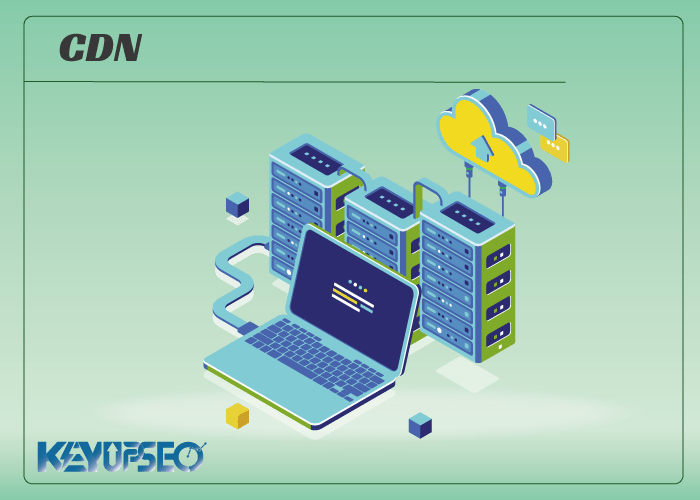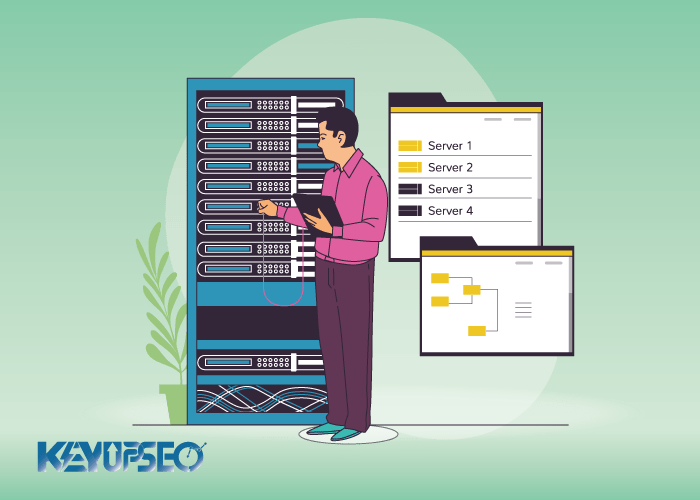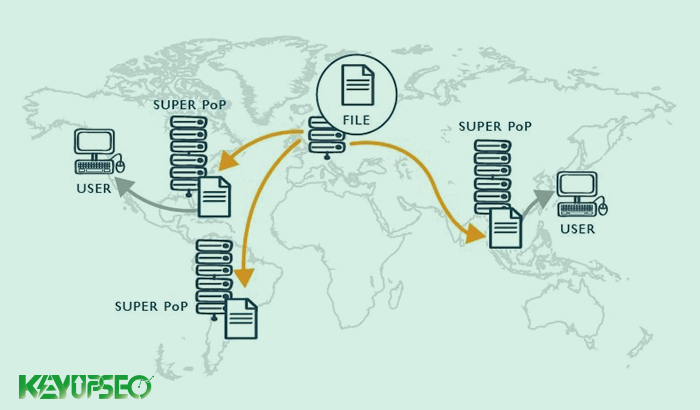
Content delivery networks
A rapid content delivery network (CDN) places website files in different locations so that the person using your web page gets the fastest version.
If you're considering a CDN, this article from Keyupseo's blog will help by showing you the steps required and determining the terms used.
No matter which content delivery company you're using, this page will take a deeper look at CDNs in general so you can make an informed decision.
Well, we are at your service again with another important topic in website and SEO so that we can make you more aware in this way.
What is a CDN?
A content delivery network (CDN) is a network of servers located in different parts of the country (or world) that store and access the files used by your website visitors.
The reason for this is that there is a measurable amount of latency (waiting time) for a website user visiting a page that is hosted thousands of miles away.
There are routing issues that can occur when a user views such a web page. If someone in New York uses a web page hosted in Los Angeles, they will see a slower version of the web page due to overhead routing issues and the distance the files have to display. Do
By having your files on multiple servers in multiple geographic areas, you can ensure that users download files that are located near them.

Does your site need a CDN?
In general, content delivery networks are part of a website strategy, but they cannot be the first step to improving your site. It's important to make sure you do everything you can before committing to the cost and complexity of a content delivery network.
I can honestly say that for many websites, there is a set of priorities:
1. Make your site amazing for your users
2. Improve the speed of your site pages
3. Share your site
4. Decide if CDN will help more
Some types of sites almost always benefit from a CDN:
• Major video streaming sites
• Sites that mainly contain large media files such as image sites
• Sites that have heavy traffic in different countries
Some sites that almost never need a CDN:
• Local business sites (restaurants, beauty salons, etc.)
• Sites that have their main traffic in a region or geographic area
Why are CDNs so popular?
The real reason many companies and webmasters are now using CDNs is that Google has started using web pages as a ranking factor. However, content delivery networks provide a faster experience for users, which means happier users who buy more things and click on more ads.
Another reason to use a CDN is the dramatic increase in tablet and mobile users, who depend on faster speeds than desktop users for more stable internet connections.
CDNs have become a de facto part of a webmaster's toolkit, and even if you don't get one now, you probably will have to later.
How much does CDN cost?
Just like almost any web service offered, there are all levels of costs for content delivery networks, from free to thousands of dollars.
Content delivery network companies
Some well-known and reliable CDN companies:
• Cloudflare (has a free option)
• Fastly
• Amazon CloudFront
• MaxCDN
• Akamai
• Cachefly
• KeyCDN

What are the difficulties of setting up a CDN?
Every content delivery network you use requires some steps that can be tedious. It's not a 5-minute job (even though they say it is). I dedicated a few hours specifically to setting up the required tasks myself and learning the ways. Time spent learning new terms, checking things out, and making sure that Your content is set up correctly.
Do my customers only need a CDN in one country?
The quick answer is yes, especially if you are in a large country like the United States. The longer answer is that if your country is very small, and you make sure you only need to communicate with people in your country, you may not need a CDN. America is a good example of a large country where CDNs provide a qualitative improvement in page speed, Liechtenstein (a country of only 70 square miles) is an example of a small country.
How do you set up a CDN?
The main steps for setting up a CDN are:
• Register for a service
• You know what files you are using
• Get your files to CDN servers
• Decide how to name your URLs (CNAME).
• Secure your web pages using the files you send to the CDN
•Testing
How CDN works
In many cases, you will use a CDN to serve things like your images, CSS, and JavaScript. These are website resources. Such files cause many problems for users who use your website from remote locations. Having these assets on servers close to your users has the positive point that your files will load faster, just because of having a content delivery network.
There are different offerings from different CDNS, but in most cases, your HTML comes from your website and your assets come from the CDN.
Getting your files from CDN servers
This simple step is not always simple, and with any CDN, you must host the files you want to serve on the CDN's web servers. Some places have options to do this for you almost automatically, and some don't.
You will like many automatic settings if you use WordPress or other content management systems.
But the main premise is the same in all CDNs. You have to host your files over the network, and this is usually a one-step process of uploading those files, once somewhere, and the content delivery network then replicates those files across its network.
Decide to CNAME your addresses.
When your files are on CDN servers, they may have different addresses. Let's fill in an example of CSS. Your old CSS file was at example.com/css/main.css, now that you're using a CDN, your CSS file is located at a URL that might look like this “dfg233445577449dhhty74 / main.css” but don't be afraid of it!
You can use these addresses for web assets, but of course, it doesn't seem to work very well, but instead we can use a name of our choice (the most common being "cdn.example.com"). ”) and after using something called a CNAME to assure our users that it is correct. This is a simple step that results in our CSS file from “cdn.example.com/main.css” which is much better.
Making sure your web pages call up the right files
This complicated step is very easy if you use WordPress or another CMS. Basically, you can make your CMS automatically change files using storage systems.
An example of WordPress is using W3 TOTAL CACHE. Every blog should use a storage system, and if you don't have one, your blog will probably have a low speed. Using caching properly takes a big step in improving page speed and offers many benefits to your users. In our case, this also helps us to automatically use files from our CDN.

CDN test
Most CDNs have a page or dashboard where you can see the usage of your files. Another way to test is to use webpagetest.org and test your site from different locations.
What is the relationship between CDN and issues?
When you start hearing about changing file names, it might scare you and worry you about your search engine optimization. Now, the truth is that a reliable CDN is a good solution to any SEO problem.
It may seem complicated!
I'll admit it may sound complicated, but it's very similar to when you first started working with a webmaster. Maybe it was a little confusing when you first did it because it was new to you, but now you know how to log in to change your host, file names, etc. without any problems.
Much like a new host, a CDN requires learning when setting it up, but the good news is that once you're up and running, there's nothing else you really need to work with. Initial setup is the main task. If this is still too complicated, make sure the CDN you are using allows you to do this.
We have a special offer for SEO professionals. You can help improve your website's SEO by using our traffic boosting tool in the KeyUpSeo user panel and Drive Targeted Traffic to Your Backlinks.
Release date : 3 January, 2023













